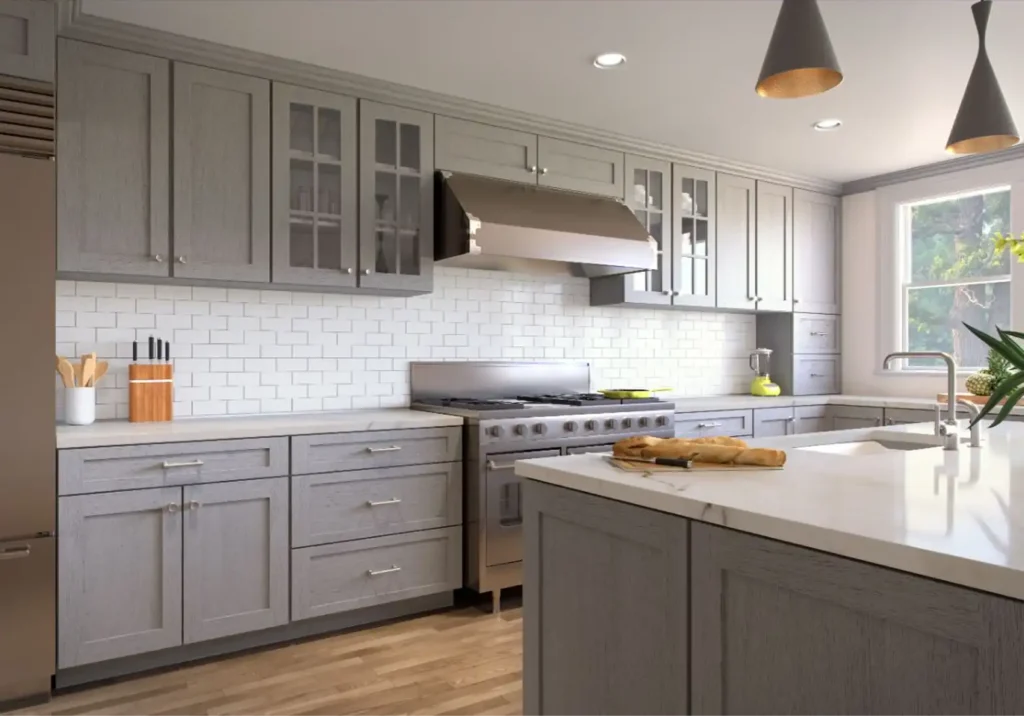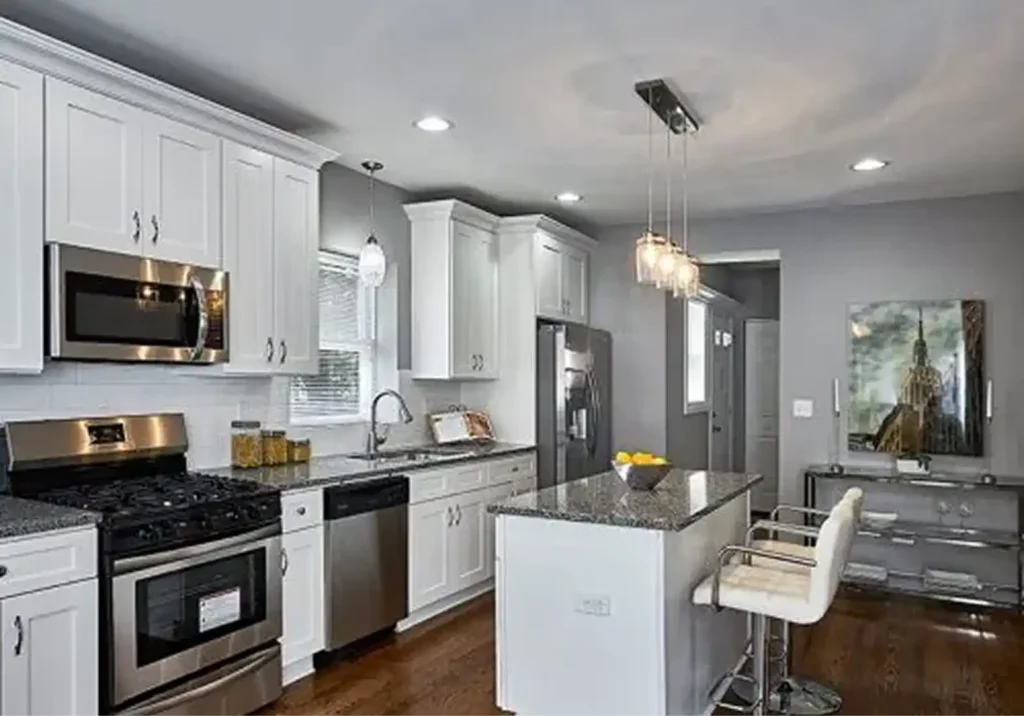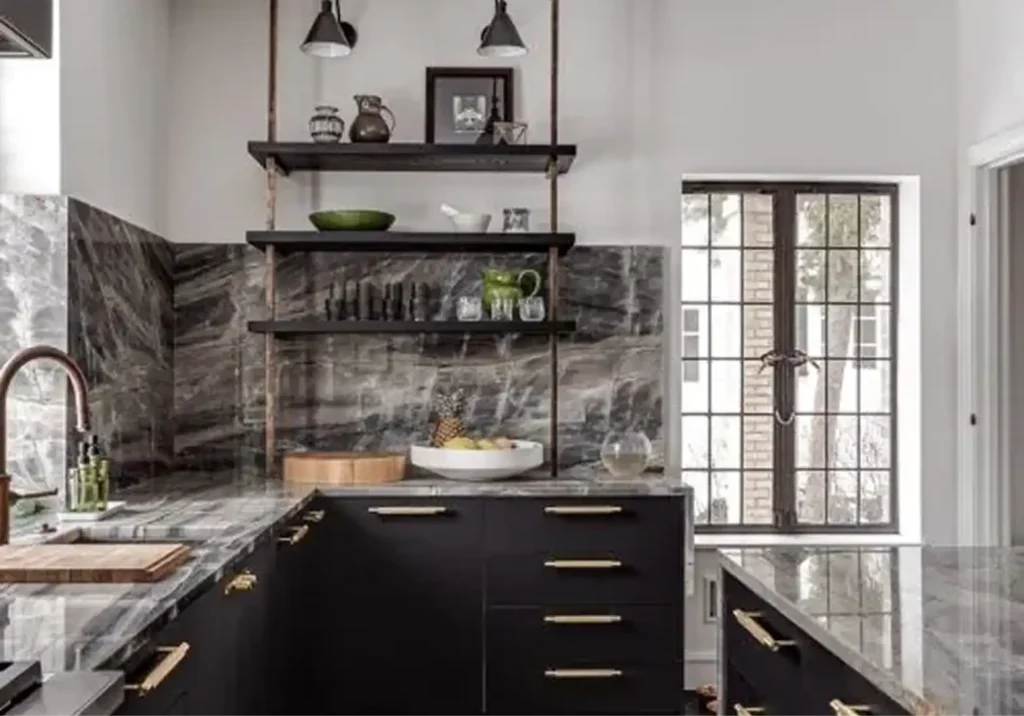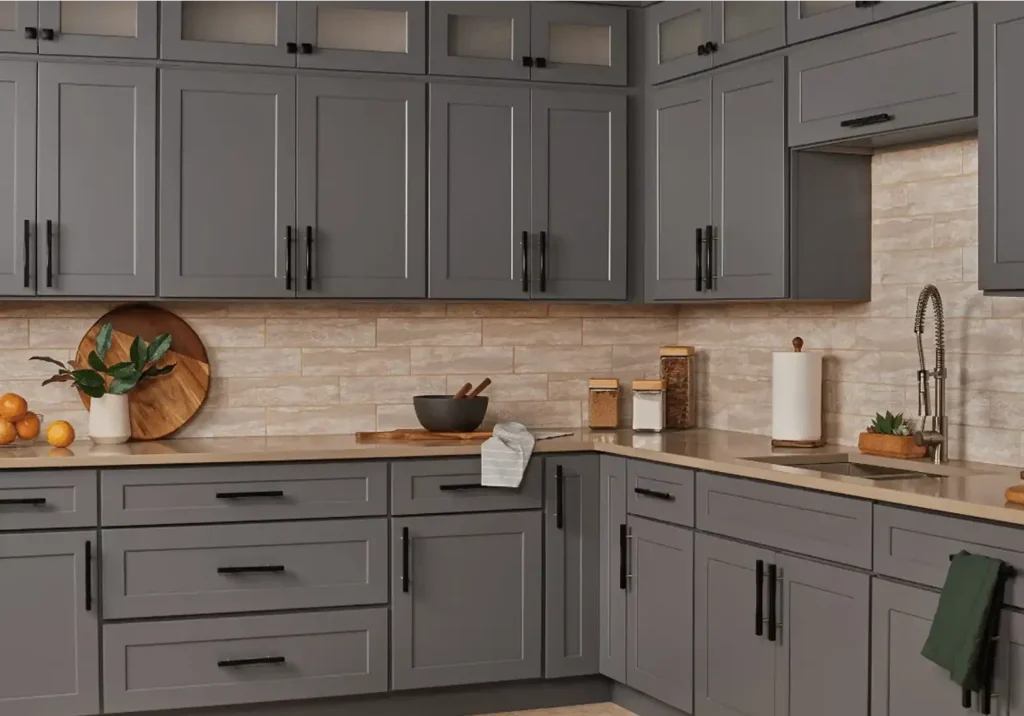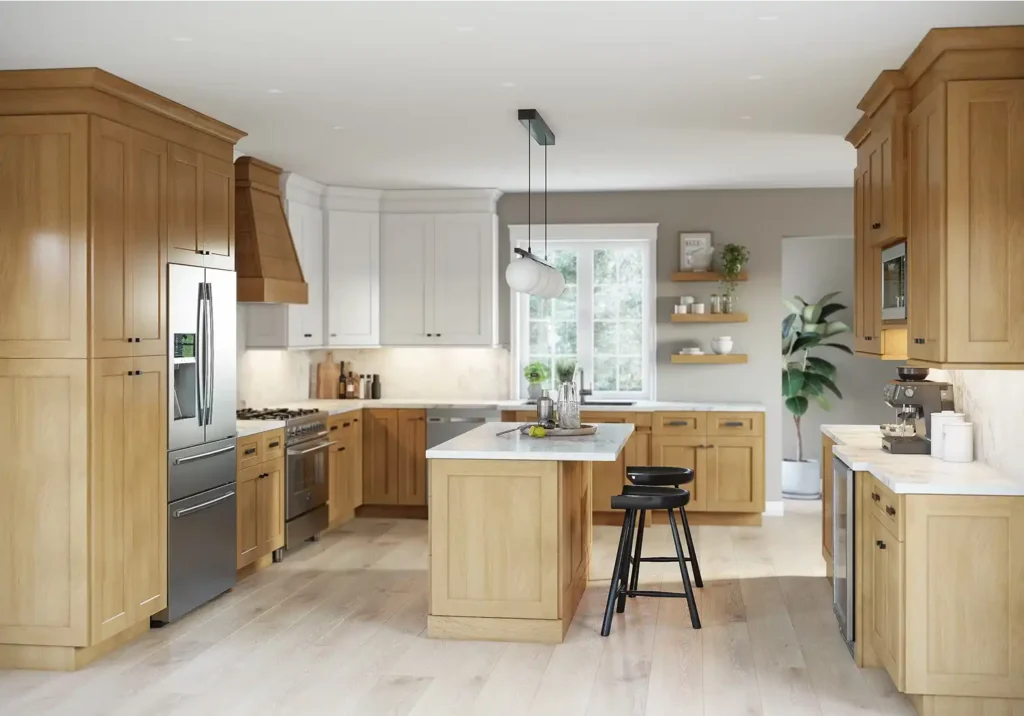Shaker cabinets feature a timeless five-piece design with a recessed center panel and are known for their simplicity, durability, and versatility. They are available in traditional, slim, and shallow styles, with options for inset, full, or partial overlay doors. Popular colors include white, gray, espresso, and green, while materials range from solid wood to MDF and plywood. Shaker cabinets are affordable, easy to maintain, and available in stock, semi-custom, custom, and RTA formats. Their clean lines and adaptable design make them ideal for modern, farmhouse, and traditional kitchens.
Table of Contents
ToggleWhat are Shaker Cabinets?
Shaker cabinets are a classic five-piece door style with a recessed center panel. They are known for their clean lines, minimal ornamentation, and timeless versatility. The simple square-frame design consists of two rails, two stiles, and a flat center, forming a practical layout that suits nearly any kitchen aesthetic, from traditional to contemporary.
The origins of Shaker cabinets trace back to the 18th century, when the Shaker religious community in the United States began crafting furniture based on values of simplicity, honesty, and utility. Their cabinetry reflected these ideals with straightforward, durable construction, free from excessive decoration. Built for longevity and function, Shaker furniture was handcrafted from abundant woods like maple, birch, pine, and cherry.
Shaker cabinets remain one of the most popular cabinet door styles in kitchens and bathrooms. Their timeless appeal lies in their flexibility; they can be painted, stained, or paired with nearly any hardware to match modern, transitional, or rustic interiors. Whether you’re remodeling a small kitchen or designing a custom layout, Shaker cabinets offer aesthetic adaptability and reliable craftsmanship that continues to stand the test of time.
What Are the Key Features of Shaker Cabinets?
Key features of Shaker cabinets are listed below:
- Recessed center panel surrounded by a clean, five-piece frame
- Cope-and-stick construction with 90-degree joints (stronger than mitered seams)
- Minimalist and timeless design that fits modern, traditional, and transitional décors
- Durable materials such as hardwood, MDF, or plywood
- Easy to clean and maintain thanks to flat surfaces and simple lines
- Highly versatile appearance, adapts to various hardware styles and finishes
- Excellent structural stability in changing humidity and temperatures
Shaker cabinets are defined by their recessed center panel, clean square edges, and timeless construction techniques that combine strength with simplicity. The design’s hallmark is its five-piece door: four flat frame pieces and a flat central panel that creates visual depth without ornate detailing.
One of the most distinguishing elements is the cope-and-stick construction, where the joints meet at 90-degree angles. This contrasts with mitered joints using angled seams (see diagram above). Cope-and-stick offers enhanced durability and flexibility, ideal for environments with temperature and humidity changes.
The minimalist design of Shaker cabinets makes them incredibly versatile and décor-neutral. Whether paired with sleek hardware in a modern kitchen or traditional knobs in a farmhouse-style room, their simplicity adapts easily to changing trends.
Built from strong materials like hardwood, MDF, or cabinet-grade plywood, Shaker cabinets are valued for their durability and easy maintenance. Their flat surfaces reduce dust buildup and make cleaning effortless with a damp cloth. This low-maintenance feature, combined with their clean design, makes Shaker cabinets a practical and enduring choice for kitchens and bathrooms alike.
What are the Types of Shaker Cabinet Designs?
Shaker cabinet designs vary in frame proportions, panel depth, and overlay styles, allowing for classic and modern interpretations. While the core five-piece construction stays consistent, subtle design variations make a noticeable impact on your kitchen’s overall style.
- Traditional vs Skinny Shaker: Traditional Shaker cabinets feature stiles and rails that range between 2¼”and 3½” (5.715 and 8.89 cm) wide, offering a balanced, timeless look. This design suits most kitchen themes, from farmhouse to transitional.
- Skinny or slim Shaker cabinets: They shrink frame widths to as little as ¾” (1.905 cm), making the center panel appear wider. This slimmer design introduces a modern, minimalist edge while keeping the Shaker roots intact.
- Slim and Shallow Shaker Variants: Modern Shaker cabinet designs include shallow step-down panels, often just ⅛” (0.3175 cm) deep compared to the standard ¼” (0.635 cm). These shallow variants reduce visual weight and give the cabinet a smoother, flatter surface that leans contemporary. They’re often paired with bold colors or handleless fronts for a sleek appearance.
Overlay Styles: Inset, Full, and Partial
Shaker cabinets are installed with inset, fully overlay, and partial door overlays, changing their visual presentation and cost:
- Inset Doors sit flush within the cabinet frame, offering a clean and tailored look but typically at a higher price point due to the precise craftsmanship required.
- Full Overlay doors cover the entire cabinet frame for a seamless, modern finish, often used in contemporary kitchens.
- Partial Overlay leaves part of the frame exposed, giving it a traditional appearance and offering cost savings compared to full overlay options.
What are Shaker Cabinets by Style?
Shaker cabinets offer versatility, adapting easily to modern, farmhouse, and traditional kitchen styles. Each aesthetic puts a different spin on the classic five-piece door, using color, hardware, and finish to align with the desired atmosphere.
Modern Shaker Cabinets: Slim Frames & Bold Finishes
Modern Shaker cabinets typically feature slim stiles and rails, often called “skinny shakers,” for a sleeker appearance. These cabinets are commonly paired with matte or high-gloss finishes in bold tones like navy, forest green, or matte black. Hardware tends to be minimal, think flat bar pulls or hidden edge pulls in chrome, black, or brushed gold. Clean lines and clutter-free visuals dominate, often paired with frameless appliances and open shelving to maintain an airy, contemporary layout.
ArtLine Kitchen and Bath’s Inspiration Tip: Combine navy slim Shaker kitchen cabinet lowers with white uppers and quartz countertops for a two-tone modern contrast.
Farmhouse Shaker Cabinets: Classic White & Rustic Hardware
The farmhouse style embraces traditional shaker proportions with wide stiles and a soft, inviting finish. White remains the most iconic choice, but soft grays, sage, and light natural wood stains dominate. Hardware typically includes cup pulls and round knobs in oil-rubbed bronze, matte black, or antique brass. Often paired with apron sinks, open shelving, and exposed wood beams, farmhouse Shaker cabinets exude warmth and functionality.
ArtLine Kitchen and Bath’s Inspiration Tip: Pair classic white Shaker kitchen cabinets with butcher block countertops and vintage bronze fixtures for a cozy, timeless look.
Traditional Shaker Cabinets: Glazed Finishes & Rich Wood Tones
Traditional Shaker kitchens lean into deeper, richer tones like cherry, espresso, and walnut, often enhanced with antique glazes. The cabinet door retains the signature recessed panel but may feature more ornate hardware such as round knobs or decorative pulls in brass or pewter. This style prioritizes warmth and sophistication, often paired with natural stone countertops and tiled backsplashes.
ArtLine Kitchen and Bath’s Inspiration Tip: Use espresso Shaker kitchen cabinetry with a travertine backsplash and aged brass fixtures to evoke a rich, traditional feel.
Each style leverages the adaptability of Shaker design, allowing homeowners to tailor the look without compromising on timeless appeal.
What are The Color Options for Shaker Cabinets?
Color plays a pivotal role in how Shaker cabinets shape the mood and style of your kitchen. Thanks to their clean, minimal design, Shaker cabinets act as a neutral base that pairs beautifully with bold and subtle tones. Below are the most popular color choices and how they influence the feel of your space.
Most Popular Shaker Cabinet Colors
- White: White is a timeless favorite among Shaker cabinet colors. It reflects natural light, helping brighten the room and making smaller kitchens appear more open and spacious.
- Gray: Gray offers a versatile neutral tone that suits modern and traditional kitchen designs. Lighter grays create a calm, serene atmosphere, while darker charcoal shades bring bold contrast.
- Espresso: Espresso Shaker cabinets feature a deep, rich brown tone that adds warmth and sophistication, especially in larger or open-concept kitchens.
- Sand: Sand provides a soft, beige-neutral hue that pairs beautifully with warm-toned hardware like brushed gold or copper, making it ideal for cozy yet refined interiors.
- Black: Black Shaker cabinets deliver a sleek, modern look with dramatic appeal. They work best when balanced with lighter elements, such as countertops or flooring, to prevent the space from feeling too dark.
- Green: Green, in earthy tones like sage or forest, has become increasingly popular for its natural, calming effect. It brings a refreshing touch to contemporary and rustic kitchens.
- Navy: Navy adds bold sophistication and pairs well with brass hardware for a high-contrast, designer finish.
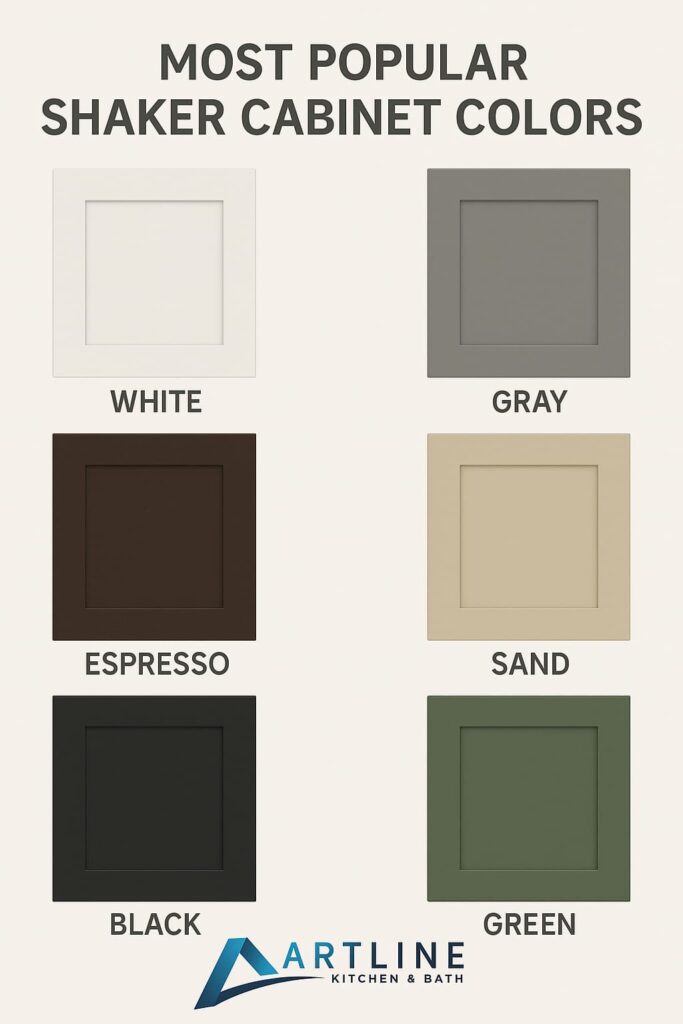
How Cabinet Color Affects Atmosphere?
- Light Reflective Tones (like white or light gray) make rooms feel larger and more inviting.
- Dark Colors (such as black or espresso) create elegant contrast but work best in well-lit or larger kitchens.
- Earthy and Natural Colors (like green or sand) add warmth and tie in beautifully with organic materials like wood or stone.
ArtLine Kitchen and Bath’s Design Tip: To highlight color, combine lower cabinets in darker tones with lighter uppers or open shelving to maintain visual balance.
What Materials are Used in Shaker Cabinets?
Shaker cabinets are crafted from solid wood, MDF, and Plywood, which influences their durability, appearance, cost, and overall performance. The choice of material plays a key role in how the cabinets will age, how easily they can be painted or stained, and how much maintenance they require.
Solid Wood Options
Solid wood is the most traditional and premium material used in Shaker cabinets, valued for its strength, beauty, and authenticity.
- Maple: Known for its smooth, fine grain and durability, maple is one of the most popular woods for Shaker cabinets. It takes paint and stain well and offers a clean, even look.
- Cherry: Offers a rich, reddish tone that darkens with age. It’s ideal for stained finishes in traditional or high-end kitchens.
- Oak: Available in red or white varieties, oak is strong and features a distinctive grain pattern. White oak is especially popular in rustic and farmhouse kitchens.
- Birch: A budget-friendly option with a uniform texture that mimics more expensive hardwoods.
- Pine: A softwood with visible knots and a more casual look, typically used in farmhouse or rustic-style kitchens.
MDF (Medium-Density Fiberboard) and Plywood
For more budget-conscious projects or painted finishes, engineered woods like MDF and plywood are excellent choices.
- MDF: MDF is ideal for painted Shaker cabinets. Its smooth surface resists warping and provides a flawless finish. However, it’s more vulnerable to water damage and less durable than solid wood.
- Plywood: Often used for cabinet boxes, plywood is lighter than solid wood and more water-resistant than MDF. High-grade plywood provides a strong and stable foundation, especially with hardwood doors.
Painted vs. Stained Finishes
- Painted Finishes: Provide a smooth, modern look and are especially popular in white, gray, or navy Shaker cabinets. They are ideal for MDF or maple wood.
- Stained Finishes: Enhance the natural wood grain, which is favored in traditional and rustic styles. Stains pair best with woods like oak, cherry, or walnut.
- Gloss Levels:
- Matte: Understated and modern, but can show fingerprints easily.
- Satin/Semi-Gloss: Popular for kitchens, offering a soft sheen and easy maintenance.
- High-Gloss: Reflective and durable, but highlights imperfections more easily.
Cost-Performance Overview (Approximate Ranges)
Material | Durability | Appearance | Cost per Linear Foot | Best For |
Maple (Painted) | High | Smooth, refined | $400–$700 | Versatile, modern, or classic |
Cherry | High | Rich, traditional | $600–$1,000 | Luxury, stained finish |
Oak | Very High | Bold wood grain | $500–$800 | Farmhouse, rustic |
MDF | Moderate | Smooth, paintable | $300–$600 | Budget-friendly, painted look |
Plywood (Boxes) | High | N/A (used structurally) | Included in box cost | All cabinet types |
Selecting the right material depends on your budget, finish preference, and long-term durability needs. For guidance, refer to our Kitchen Cabinet Guide to match your kitchen style with the ideal cabinet material.
Are Shaker Cabinets Durable and Affordable?
Shaker cabinets are well-regarded for their long-lasting performance and cost-effective design, making them a wise investment for many homeowners.
With their simple five-piece construction and solid joinery, Shaker cabinets offer a long lifespan with basic care, often exceeding 20 years. Their clean, flat surfaces make daily maintenance easy; dusting and occasional wiping with a damp cloth are usually enough to keep them looking pristine.
Shaker cabinets are more affordable due to their minimal design and efficient production methods compared to more ornate cabinetry styles with carved details or elaborate moldings. Prices can vary based on materials and finishes, but they generally fall in the mid-range category, offering an excellent balance between cost and quality.
From a real estate perspective, Shaker cabinets retain their appeal across decades and design trends. Their timeless look and widespread popularity often contribute positively to home resale value. Whether you’re remodeling for yourself or preparing your home for sale, Shaker cabinets provide visual appeal and return on investment.
Pros and Cons of Shaker Cabinets
Shaker cabinets offer a perfect blend of timeless design, versatility, and affordability, making them a favorite in traditional and modern kitchens. However, their simplicity may not suit every style preference, and some practical considerations, like dust collection, should be noted.
Advantages of Shaker Cabinets
- Timeless Design: Their clean lines and simple structure make them adaptable to nearly any kitchen style, from farmhouse to contemporary.
- Easy to Maintain: The smooth surfaces and minimalist design are easy to clean, requiring minimal upkeep.
- Versatile Styling: Compatible with various finishes, colors, and hardware, they serve as a flexible base for customization.
- Cost-Effective: Generally more affordable than ornate cabinetry, especially in semi-custom or stock formats.
- Resale Value: Their widespread appeal adds long-term value to your kitchen, benefiting future resale.
Disadvantages or Limitations of Shaker Cabinets
- Dust Accumulation: The recessed center panel can collect dust or grime, requiring occasional deep cleaning.
- Simplistic Aesthetic: Those looking for intricate, decorative cabinetry may find the design too plain or minimal.
- Customization Costs: Custom-built Shaker cabinets, especially with premium materials or finishes, can increase kitchen renovation costs.
Custom, Semi-Custom, and Stock Shaker Options
Shaker cabinets are available in all three cabinetry formats, stock, semi-custom, and custom, making them highly accessible for various budgets and kitchen remodeling goals.
- Stock Shaker Cabinets: These are mass-produced and sold in standard sizes and finishes. They’re perfect for budget-conscious projects or fast turnarounds.
Price range: $100–$400 per linear foot - Semi-Custom Shaker Cabinets: These offer more flexibility in dimensions, colors, and features while using standard cabinet boxes. They are ideal for homeowners who want a personalized kitchen without the full custom cost.
Price range: $150–$700 per linear foot - Custom Shaker Cabinets: These are fully made-to-order based on your layout, materials, and design specs. They are perfect for high-end remodels, unique kitchen layouts, or long-term investments.
Price range: $500–$1,200+ per linear foot
RTA vs Pre-Assembled Availability of Shaker Cabinets
Shaker cabinets are commonly available in RTA (Ready-to-Assemble) and pre-assembled formats across all tiers:
- Stock and semi-custom Shaker cabinets are often available as RTA to reduce shipping and assembly costs.
- Custom Shaker cabinets are typically pre-assembled by skilled craftsmen.
Best Use by Project Type
- Stock Shaker: Ideal for rental properties, flips, or small kitchen makeovers.
- Semi-Custom Shaker: Great for primary home renovations with moderate design needs.
- Custom Shaker: Best suited for luxury kitchens, unconventional layouts, or homeowners planning to stay long-term.
These format choices allow Shaker cabinets to meet a wide range of aesthetic goals, practical needs, and price points, without sacrificing their core appeal.
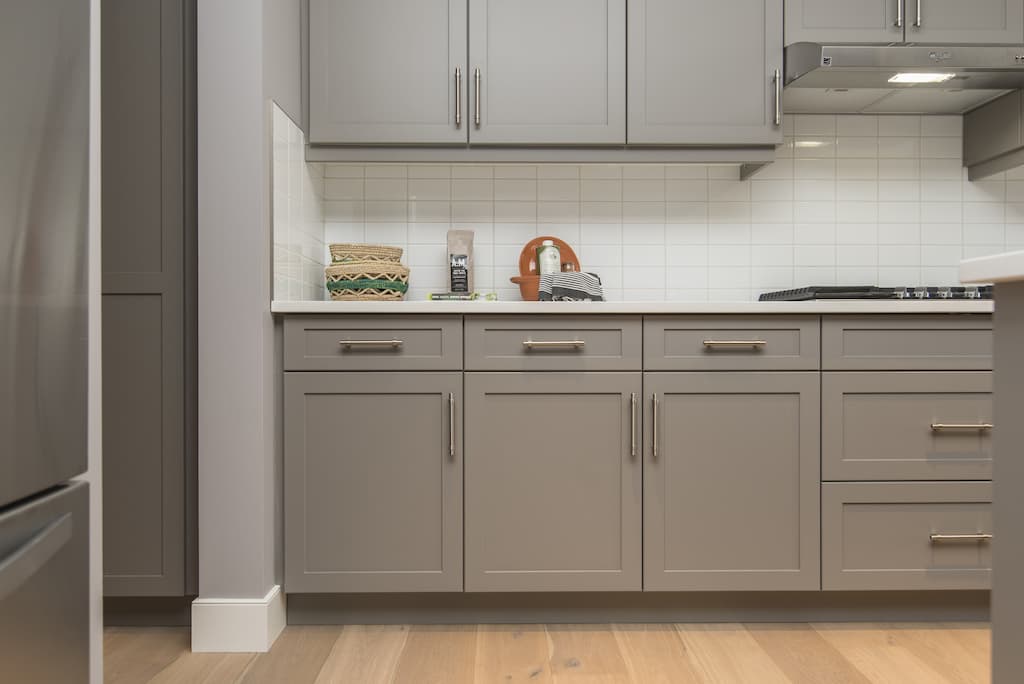
Hardware & Accessories for Shaker Cabinets
Shaker cabinets pair beautifully with a wide range of hardware, allowing you to fine-tune the style of your kitchen, whether you prefer a timeless look or a more contemporary feel.
Knobs vs. Pulls: Traditional vs. Modern
- Knobs are a classic choice, especially in traditional or farmhouse kitchens. Round or square knobs in aged brass or oil-rubbed bronze echo the simplicity of Shaker design and reinforce its historical roots.
- Pulls, especially long linear bar pulls, bring a modern flair to Shaker cabinets. They are more common in contemporary and transitional kitchens and can emphasize the clean lines of the recessed panel.
Material Matching for Cohesive Design
When selecting hardware, consider coordinating with your faucet, lighting, or appliances:
- Bronze or Oil-Rubbed Bronze: Perfect for warm-toned kitchens with beige, sand, or espresso cabinets.
- Brushed Nickel: A versatile, soft-finish metal that complements white and gray Shaker cabinets.
- Polished Chrome: Ideal for sleek modern spaces, especially paired with navy or black Shaker doors.
- Matte Black: Works well in minimalist kitchens, adding bold contrast to light-colored cabinets.
Tips for Mixing and Matching Without Disrupting Style
- Use pulls on drawers and knobs on cabinet doors to create variety without visual clutter.
- Keep finishes consistent throughout the kitchen, even when mixing knobs and pulls.
- Choose hardware that echoes the cabinet’s proportions. Slim shaker styles benefit from slender pulls, while standard profiles can accommodate chunkier hardware.
With the proper hardware and accessories, you can subtly shift the tone of your Shaker cabinets, enhancing their simplicity or giving them a striking edge, all while maintaining design harmony.
FAQs About Shaker Cabinets
Shaker cabinets are timeless because their clean lines, recessed panel design, and minimalist aesthetic adapt to nearly any kitchen style, from traditional to contemporary. Their balance of simplicity and function makes them relevant across design trends and decades.
The main difference between Euro and Shaker cabinets is their construction and appearance. Shaker cabinets feature a five-piece door with a recessed center panel, while Euro-style cabinets are frameless, flat-panel doors known for sleek, seamless lines and a modern look.
Yes, Shaker cabinets can be modern when styled with slim rails, bold colors like navy or matte black, and minimalist hardware. Modern Shaker cabinets preserve the traditional frame-and-panel structure while embracing contemporary finishes and layouts.
Shaker cabinets are an excellent choice for small kitchens due to their clean lines and light-reflective color options, such as white or sand. The simple design helps create a more open, uncluttered appearance that visually expands limited space.
Yes, Shaker cabinets are widely available in RTA (Ready-to-Assemble) formats, offering affordability and convenience for DIY remodels. RTA Shaker cabinets retain the same five-piece construction and are ideal for cost-effective kitchen upgrades.
Best Kitchen Cabinet Brands
We offer a superior selection of kitchen and bathroom cabinets for all your storage needs!
Final Thoughts: Should You Choose Shaker Cabinets?
Shaker cabinets are one of the most versatile, durable, and enduring cabinet styles available. They are suited to nearly every kitchen aesthetic, from modern to farmhouse to traditional. Their timeless five-piece construction, affordability across stock, semi-custom, and custom formats, and wide range of color and hardware options make them a smart choice for renovations and new builds.
Whether you’re drawn to crisp white finishes, dramatic dark tones, or natural wood stains, Shaker cabinets offer a reliable foundation for your kitchen design. Visit our kitchen cabinet service page to find the brands and designs you like. If you’re unsure which type, overlay, or finish is right for your layout and budget, contact one of our kitchen cabinet designers for a personalized consultation and expert guidance tailored to your space.


